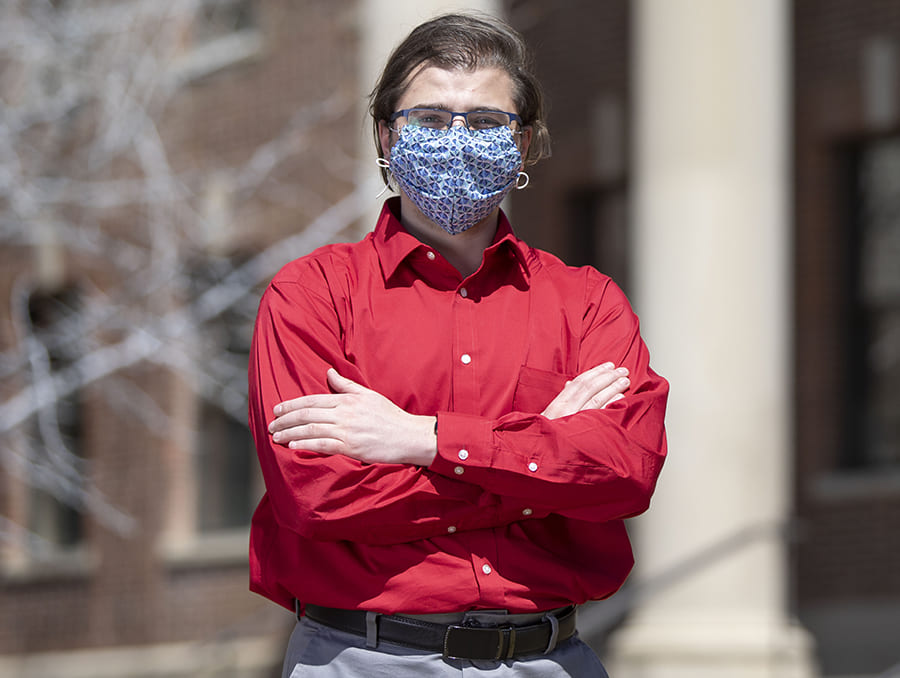Department of Civil & Environmental Engineering doctoral student William Roser was recently named a National Science Foundation Graduate Research Fellowship Program awardee. Through a competitive process, the GRFP awards fellows a three-year annual stipend of $34,000 along with a $12,000 cost of education allowance awarded to the institution, waived tuition, opportunities for research, professional development, and the ability to conduct their own research at any graduate school they choose.
“I’m still in shock,” Roser said of receiving the award. “It means a lot to have outside indication that your research is valuable to the community and that it will benefit society. Receiving the GRFP is a nice vote of confidence because you are put up against thousands of applicants who were all great.”
While Roser may feel shock over winning the award, his mentor, Professor Keri Ryan, was not surprised. “He is among the sharpest and most hard-working students I have worked with, and the award is truly deserved,” Ryan said. “William showed a remarkable ability to take some high-level details and run with them to develop a comprehensive, convincing research plan. I am sure the reviewers recognized this, and it was a significant factor in selecting him. I would like to acknowledge the support services in place by the graduate school—GRFP workshops and editorial review services—helping students across campus to raise the caliber of their applications.”
Working with Ryan, Roser’s research focuses on the performance of nonstructural elements of buildings—non-load-bearing elements, like stairwells—during seismic activities. Often, after earthquakes, a building is standing, but certain nonstructural elements may be so compromised that the building needs to be torn down anyway.
Ryan elaborated, “William’s research scope includes the simulation, testing and validation of connection details for nonstructural components subject to earthquake loading. These are the non load bearing systems that serve other functions in the building and have to go along for the ride; they have received little attention compared to structural systems.”
Improving the performance of these nonstructural elements will, ultimately, not only make buildings safer, but it will also make buildings more environmentally friendly by reducing the need to use new materials and resources after an earthquake.
Roser places a high value on the ability of engineers to make an environmental impact. In addition to his GRFP award, Roser is one of the inaugural Fellows in the Graduate Assistance in Areas of National Need (GAANN) PhD Program, sponsored by the Department of Education. The program supports graduate student research that focuses on areas of need on the national level. Specifically, the University’s program, directed by Ryan, has identified the theme of “Rebuilding the Nation’s Infrastructure for Resilience to Extreme Events.”
“We need to get rid of our culture of throwing things away,” Roser said. “Using building materials and methods that are not sustainable requires a huge carbon output. We can support our goal of reducing waste by designing buildings that can move with earthquakes.”
For Roser, one of the keys to his research and its ability to reduce the negative environmental impact of building new structures is the material he is studying. Instead of concrete and steel, the researchers are looking at ways to increase the resiliency of large structures made of timber.
“Timber is an attractive, sustainable material, because it grows on trees,” Roser said. “We hope to find ways to make timber buildings taller through the creation of ‘rocking walls’ that allow buildings to move more during earthquakes.”
An extension of the idea of bending without breaking, “rocking walls” that enable buildings to move while maintaining their integrity will reduce the likelihood that the building will have to be demolished after seismic activity.
Ryan concluded, “The details considered in this project — to be validated on a shake test of a 10-story building — represent the state-of-the-art.”
Learn more about the National Science Foundation Graduate Research Fellowship Program (NSF GRFP) and the Graduate Assistance in Areas of National Need (GAANN) PhD Program in the Department of Civil & Environmental Engineering.














